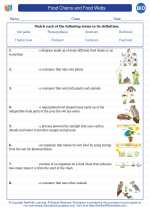Food Chains and Food Webs -> velocity
Velocity
Velocity is a vector quantity that describes the rate at which an object changes its position. It is the displacement of an object divided by the time taken to travel that distance. Velocity is typically measured in units of distance per time, such as meters per second (m/s) or kilometers per hour (km/h).
Calculating Velocity
The formula for calculating velocity is:
Velocity (v) = Displacement (Δx) / Time (Δt)
Types of Velocity
There are two main types of velocity:
- Instantaneous Velocity: The velocity of an object at a specific instant in time.
- Average Velocity: The total displacement of an object divided by the total time taken.
Velocity vs. Speed
It's important to note that velocity and speed are often used interchangeably in everyday language, but they have different meanings in physics. While velocity includes the direction of motion, speed is a scalar quantity that only measures the rate of motion without considering direction.
Units of Velocity
Velocity is typically measured using the following units:
Velocity and Acceleration
Velocity is related to acceleration, which describes the rate of change of velocity. When an object's velocity changes, it is said to be accelerating. The relationship between velocity (v), initial velocity (u), acceleration (a), and time (t) is given by the equation:
v = u + at
Study Tips for Velocity
When studying velocity, it's important to:
- Understand the difference between velocity and speed.
- Practice calculating velocity using the formula v = Δx / Δt.
- Be familiar with the units of velocity and how to convert between them.
- Review the relationship between velocity, acceleration, and time.
- Work on problems and examples to solidify understanding.
[Velocity] Related Worksheets and Study Guides:
.◂Biology Worksheets and Study Guides High School. Food Chains and Food Webs

 Worksheet/Answer key
Worksheet/Answer key
 Worksheet/Answer key
Worksheet/Answer key
 Vocabulary/Answer key
Vocabulary/Answer key
 Vocabulary/Answer key
Vocabulary/Answer key
